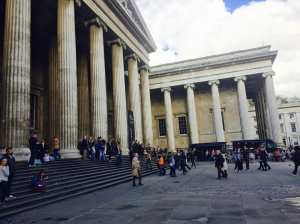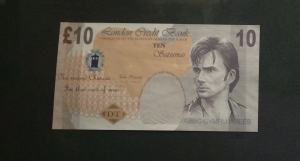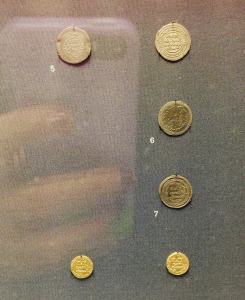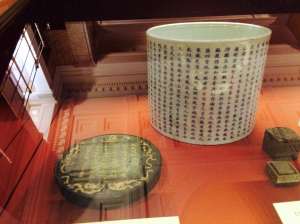This weeks dissertation class was held at the British Museum! We all met on the front steps on Wednesday afternoon and were briefed on the afternoons task. We were to walk around for an hour and a half and find objects and pieces around the museum that reflected or showed the medium and process of writing and in what way.
I set off towards the European section and started at the Etruscan part of that section, I noticed at first that there wasn’t a lot of objects and exhibits that had writing on the actual artifact and it wasn’t until I was in the Roman Empire section that I found some memorial reliefs dedicated to people. There was also a lot of these but I also found some really interesting pieces from the part of the Roman section on the Roman Army, they had pieces of what looked like terracotta pottery or ceramic with ink inscriptions on them and were actually letters to people, some were warning people of events and others were just between father and son. I liked these because they were a but more personal than the memorial slabs which were a bit more official and probably glorified.
I then walked through the money section and had a little look and I came across some printed money that was used for props in TV and movies and noticed one for Doctor Who which had an accompanying video showing the scene were the 10 “pound” notes were used, but as you can’t legally print money they created their own note that had the same colour scheme and over all image placement of a standard £10 note but the portrait was instead the Doctor at the time David Tennant and instead of ’10 pounds’ it said ’10 satsumas’ and had a quote from the show on the note. As a fan of the show I thought it was cool finding out that little bit of info but also amusing in the way they recreated it, paying attention to quite a bit of detail to make it look as real as possible without copying.
Back to the task at hand! I also found in the money section old Ancient Islamic coins from the Umayyad Empire (649-7 AD) that had a proclamation of faith inscribed into the coins. I thought it was an interesting use of writing on such a small object.
I then walked through past the Medieval Europe part of the museum and decided to look somewhere different and found myself in the Enlightenment Era which was decked out to look more like an old library in somewhere like the V&A than a museum, it made it seem very atmospheric to the era. It was here I found the object that I would talk about when we would regroup afterwards. I found a Chinese brush pot and ink cake. I read some of the facts about it and the Chinese writing on the pot and cake is not tied to the spoken language, that the characters work on a pictographic base using symbols to stand for a group of words. They apparently form the oldest writing system still in use. These objects are covered in only a fraction of more than 50,000 known characters.
We met back at the steps outside and everyone mentioned a piece that they had found and we discussed around them and talked more about the weeks to come before we all parted ways.
It was an interesting visit as I hadn’t been to the British Museum with a mission or select idea in mind so it was more of a focused visit and I had fun wandering around areas that I might not have paid attention to before.






